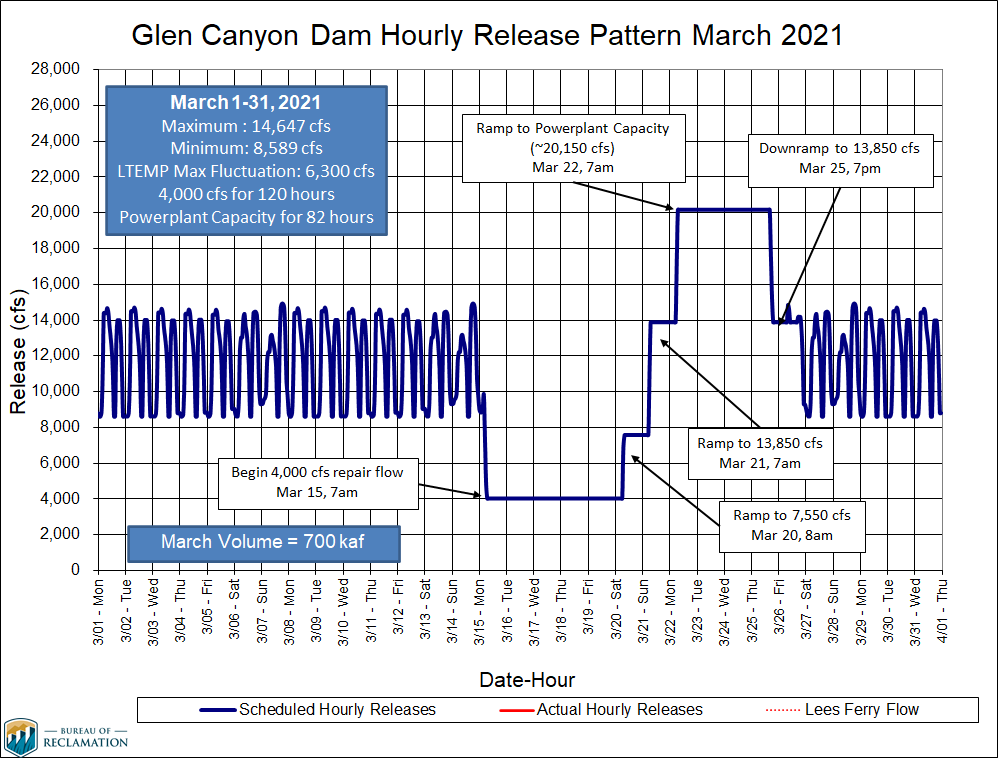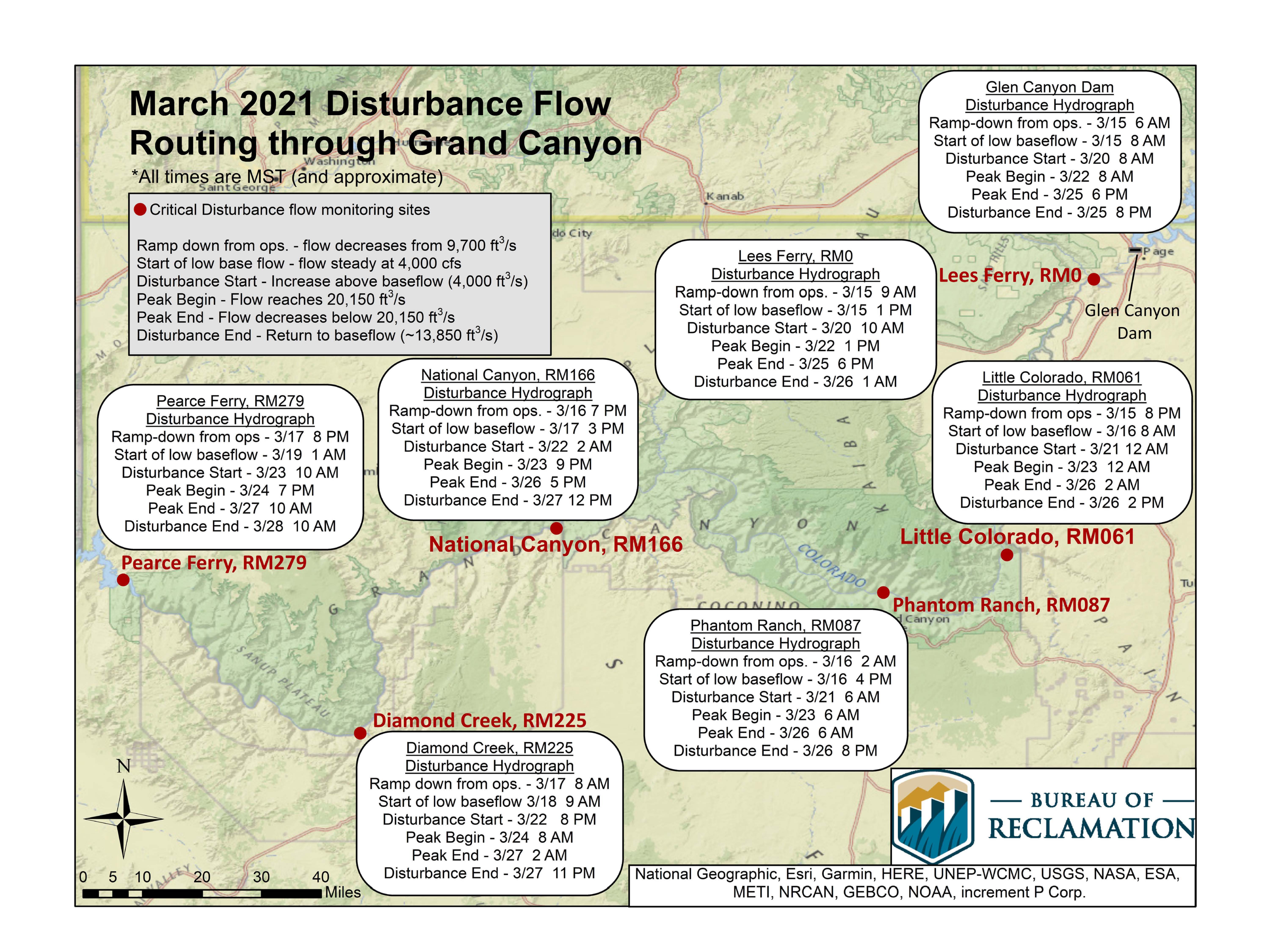- Reclamation
- Upper Colorado Region
- Glen Canyon Dam Adaptive Management Program
- Glen Canyon Dam Spring Disturbance Flow
Glen Canyon Dam
Spring Disturbance Flow
The Department of the Interior will conduct a spring disturbance flow release from Glen Canyon Dam, Arizona, beginning March 15 at 5 a.m. and ending March 26 at 8 a.m.
A spring disturbance flow is planned at Glen Canyon Dam from March 15 to March 26. It is expected to maximize ecosystem benefits to the Colorado River ecosystem through the Glen, Marble, and Grand canyons, while meeting water delivery requirements and minimizing negative impacts to hydropower production. The spring disturbance flow will not affect the monthly or annual release volumes from Lake Powell through Glen Canyon Dam.
The spring disturbance flow capitalizes on a unique low flow of 4,000 cubic feet per second for 5 days, which is needed to conduct maintenance on the apron of Glen Canyon Dam. This low flow will be followed by a gradual increase to higher releases that will culminate in a discharge of approximately 20,150 cubic feet per second for 82 hours. The peak release of the spring disturbance flow will stay within the maximum release levels allowed under normal operations.
This combination of low and high flows is expected to disturb river bottom habitats and may drive positive aquatic ecosystem responses like increased algae and insect production. This could increase aquatic insect prey available for endangered humpback chub, non-native rainbow trout, an important sportfish, as well as other wildlife. The spring disturbance flow may disadvantage brown trout in Glen Canyon by reducing survival of emerging fry. The spring disturbance flow may also provide new scientific information that can be used in future decision making.
Recreational users are reminded to exercise caution along the Colorado River through Glen and Grand Canyons during the entire spring disturbance flow period.
The spring disturbance flow will begin with a reduction in flows to 4,000 cubic feet per second starting on March 15 at 5 a.m., reaching 4,000 cubic feet per second at 7:00 a.m.
- Releases will remain at this level for 120 hours (5 days), through 6:59 a.m. on March 20.
- Releases will then increase gradually over three days, from March 20 to March 22, to a peak release of approximately 20,150 cubic feet per second.
- This peak will be sustained for 82 hours.
- Standard operations of Glen Canyon Dam will resume at March 26 at 8 a.m.
- Under normal operations, daily releases at Glen Canyon Dam during March 2021 would range from a high of 14,647 cubic feet per second to a low of 8,589 cubic feet per second.


On January 29, 2021, the Glen Canyon Planning/Implementation Team recommended conducting spring disturbance flow releases at Glen Canyon Dam from March 15 to March 26, 2021. The spring disturbance flow was developed and evaluated within the adaptive management framework and provisions of the 2016 Record of Decision for the Glen Canyon Dam Long Term Experimental and Management Plan Record of Decision. The LTEMP ROD specifies the representation requirements for planning experiments at Glen Canyon Dam and is based on past successful planning and implementation of flow-based experiments. The Team includes technical representatives from the Bureau of Reclamation, the National Park Service, the U.S. Fish and Wildlife Service, the Bureau of Indian Affairs, the U.S. Geological Survey's Grand Canyon Monitoring and Research Center, Western Area Power Administration, the Arizona Game and Fish Department, the seven Colorado River Basin States , and the Upper Colorado River Commission.
Under the 2016 LTEMP ROD High Flow Experiments are the primary type of flows that cause disturbance to the Colorado River ecosystem downstream of Glen Canyon Dam. Past studies have indicated that impacts to natural processes and other biological resources would be maximized with spring-timed HFEs, while building of beaches and sand bars would be maximized with fall-timed HFEs. To fill the knowledge gap left by infrequent Sediment-Triggered Spring HFEs, Adaptive Management Work Group (AMWG) subcommittees worked to develop a spring disturbance flow hydrograph that includes a high spring release within the normal operating constraints of the 2016 LTEMP ROD (i.e. 25,000 cubic feet per second).

